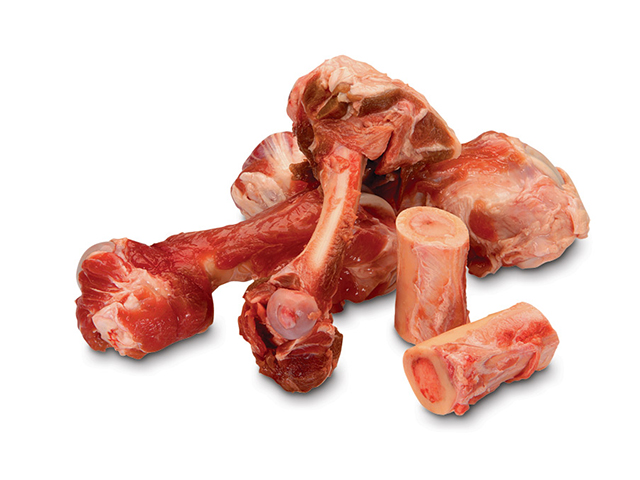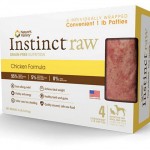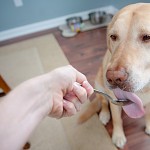In a recent poll, 91% of pet owners consider their animals to be an important part of the clan,1 an evolutionary process that began over 12,000 years ago when the first hunter-gatherers began to domesticate dogs.2 In fact, Americans care so much for their pets, they spent approximately $60 billion on their pets last year, with close to $22 billion on food alone.3 However, although many commercial pet food brands market themselves as natural and organic, a Paleo style diet may truly be best for our pets.
Scientific research comparing the health benefits of a Paleo Diet to the standard pet foods found in grocery stores is limited. Despite the lack of specific research pertaining to pet nutrition, the risks of food-borne illness of raw food,4 and the fear it would be cost prohibitive, it took my own dog being diagnosed with Irritable Bowel Disease, which included scaring on her intestines blocking absorption of certain nutrients and periodic episodes of pancreatitis, for me to give it a try. I wish I had done it sooner, as we know an ancestral approach to nutrition has the power to reduce disease and increase the standard of living for humans, why shouldn’t this apply to the animals in our lives?
Researchers have studied modern day hunter-gatherer populations to understand how traditional populations have sourced food.5 Similarly, we can look to the African wild dogs, described as social carnivores that hunt in packs6 along with the active hunting behaviors of well-fed domesticated cats7 to provide evidence that our four legged pets might not be genetically designed to eat a grain-based diet. I can use first hand observations of my dogs’ innate, primal response to cats, chickens, squirrels, and birds on their daily walks in our urban neighborhood to clearly see they are driven to hunt for their food.
Even without concrete evidence that our pets are genetically designed to follow a Paleo Diet8, consisting of real meat, organs, and with the correct balance of anti-inflammatory Omega-3 rich fatty acids,9 I think we can all agree that processed commercial pet foods can impact digestibility, nutrient bioavailability, and aren’t safe for consumption.10 In 2007 many foods were recalled for containing toxins, such as melamine and cyanuric acid, that led to renal failure in both cats and dogs.11,12
These recalls focused new attention on pitfalls within the manufacturing process, but many still failed to see how commercial pet foods consist of low-quality, cheap protein sources, fillers such as grains, and additives including sweeteners like high fructose corn syrup.13 Are these really the food sources we would choose in the best interest of ones we love? Take a look at the label on the food you buy and you may see some of the following main ingredients:
- Chicken by-product meal. A dry rendered product of slaughterhouse waste, consisting of feet, beaks, feathers undeveloped eggs, and everything else besides the prime cuts that have been removed.14
- Corn and wheat. Often contaminated with mold as a result of growing conditions or extended storage. These molds often easily grow and produce aflatoxins, a very potent carcinogen. Exposure to these toxins, even at low doses, can cause anemia, liver or kidney failure, cancer and premature death.15
- Soybean meal. A genetically modified legume, created as a by-product of soybean oil production and commonly found in industrial farm animal feed, acts as both a filling agent and a protein source.16
Racing greyhounds and sled dogs are known for following a raw food, Paleo diet17 and the concept has been gaining momentum to the family pet, as owners seek to improve their pet’s health.18 Owners whose animals follow a raw food diet believe it enhances immune function, overall health and energy, improves skin and coat condition, and alleviates chronic digestive, allergic and metabolic diseases.19,20
My dog has seen a vast improvement in her health and overall behavior now that she is eating a raw Paleo diet. Truly understanding how the evolution away from our pet’s ancestral diet has led to an increased incidence of diseases,21 such as pet allergies, skin issues, arthritis, diabetes, cancer, anxiety and obesity, accompanied by astronomical veterinary bills, might be all it takes to begin looking at how we feed our pets in a way that best suits their needs and consider a Paleo diet for pets.
| Dog Calorie Calculator by TrainPetDog |
Sources
[1] “Pets Really Are Members of the Family.” Harris Interactive: Harris Polls. N.p., n.d. Web. 13 Apr. 2015.
[2] Morey, Darcy F. “The early evolution of the domestic dog.” American Scientist(1994): 336-347.
[3] “Americans Spent a Record $56 Billion on Pets Last Year.” CBSNews. CBS Interactive, n.d. Web. 13 Apr. 2015.
[4] Finley, Rita, et al. “Human health implications of Salmonella-contaminated natural pet treats and raw pet food.” Clinical infectious diseases 42.5 (2006): 686-691.
[5] Milton, Katharine. “Hunter-gatherer diets—a different perspective.” The American journal of clinical nutrition 71.3 (2000): 665-667.
[6] Creel, Scott, and Nancy Marusha Creel. “Communal hunting and pack size in African wild dogs, Lycaon pictus.” Animal Behaviour 50.5 (1995): 1325-1339.
[7] Fitzgerald, B. MIKE, and Dennis C. Turner. “Hunting behaviour of domestic cats and their impact on prey populations.” The domestic cat: the biology of its behaviour. Edited by DC Turner and P. Bateson. Cambridge University Press, Cambridge (2000): 151-176.
[8] Sudano, Maurizio, and Franco Gregorio. “Ancestral diets and modern diseases.” Mediterranean Journal of Nutrition and Metabolism 4.3 (2011): 181-189.
[9] Mooney, M. A., et al. “Evaluation of the effects of omega-3 fatty acid-containing diets on the inflammatory stage of wound healing in dogs.” American journal of veterinary research 59.7 (1998): 859-863.
[10] Buff, P. R., et al. “Natural pet food: A review of natural diets and their impact on canine and feline physiology.” Journal of animal science 92.9 (2014): 3781-3791.
[11] Burns, Katie. “Recall shines spotlight on pet foods.” Recall (2007).
[12] Brown, Cathy A., et al. “Outbreaks of renal failure associated with melamine and cyanuric acid in dogs and cats in 2004 and 2007.” Journal of Veterinary Diagnostic Investigation 19.5 (2007): 525-531.
[13] Thompson, Angele. “Ingredients: where pet food starts.” Topics in companion animal medicine 23.3 (2008): 127-132.
[14] Papadopoulos, Manthos C. “Processed chicken feathers as feedstuff for poultry and swine. A review.” Agricultural Wastes 14.4 (1985): 275-290.
[15] Knueven, Doug, DVM, CVA, CAC. The Holistic Health Guide, Natural Care for the Whole Dog. (2008)
[16] Rumsey, T. S., T. H. Elsasser, and S. Kahl. “Performance and digestibilities of beef cattle fed diets supplemented with either soybean meal or roasted soybeans and implanted with Synovex.” Journal of animal science 77.7 (1999): 1631-1637.
[17] Schlesinger, Daniel P., and Daniel J. Joffe. “Raw food diets in companion animals: A critical review.” The Canadian Veterinary Journal 52.1 (2011): 50.
[18] Pottenger, Francis Marion. Pottenger’s cats: a study in nutrition. Price-Pottenger Nutrition Foundation, 1983.
[19] Stogdale L, Diehl G. In support of bones and raw food diets [Letter] Can Vet J. 2003;44:783.
[20] Billinghurst I. Feeding the adult dog. Give your dog a bone. Alexandria, Australia: Bridge Printery, 1993:265–280.
[21] Jew, Stephanie, Suhad S. AbuMweis, and Peter JH Jones. “Evolution of the human diet: linking our ancestral diet to modern functional foods as a means of chronic disease prevention.” Journal of medicinal food 12.5 (2009): 925-934.











